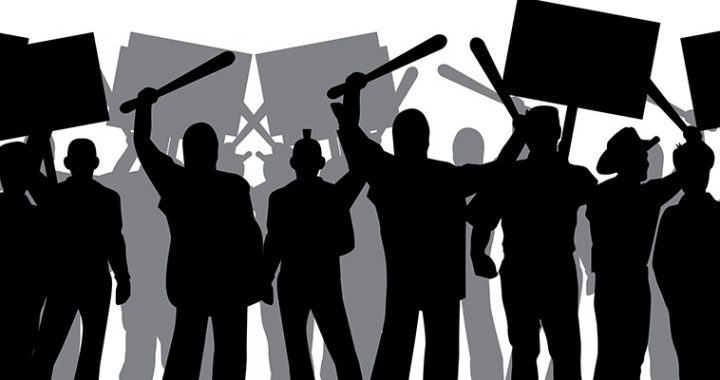September 6, 2020
The scribes and the Pharisees brought a woman who had been caught in adultery; and making her stand before all of them, they said to Jesus, “Teacher, this woman was caught in the very act of committing adultery. Now in the law Moses commanded us to stone such women. Now what do you say? ~ John 8:3-5
When I was a senior in high school, we played a football game in Lake Dallas and after the game we stopped at a restaurant to chow on chicken fried steak and rehash the game. After eating I walked out of the restaurant and saw that two strangers had Gary Don pinned up against the wall. Gary Don was always getting into trouble. Richard Story looked at me and said, “I wouldn’t go over there.”
I ignored him and walked toward the strangers and Gary Don. When I got close, one of the kids faced me, pointed a knife at me, and said, “Get out of here if you know what’s good for you.” Gary Don was terrified and so was I.
What should I have done? Fight or flight?
Unfortunately, conflict is as much a part of our lives as the air we breathe. How we respond to conflict is of upmost importance especially during these days of division in our country? Is there a healthy, restorative way to resolve conflict? Can we find alternative ways to resolve conflict in our marriages, with our children and with our parents? Can we mitigate conflict between the rich and the poor, Republicans and Democrats? Can we find common ground between different faith traditions? Conflict is everywhere.
Jesus faced heated conflict with his disciples, the scribes and the Pharisees, King Herod and Pontius Pilate, and his own family. Like us, he could not avoid or escape conflict.
How do we address conflict in our lives? Do we fight? Ignore it, deny it, or hope it just magically goes away? Do we flee? How often do our disagreements end up in knock down drag outs and our words or actions wound or hurt the people we love as well as ourselves?
Walter Wink in his book Jesus and Nonviolence says there are three general responses to conflict: passivity, violent opposition, and the third way of nonviolence articulated by Jesus. Human evolution has conditioned us for only the first two of these responses. Wink writes that Jesus abhors both passivity and violence as responses to evil and/or conflict. The way of Christ is a third alternative, the narrow way, the third way, or some call it the middle way.
Some male Jewish leaders bring a woman caught in the act of adultery to Jesus. They corner him in a conflict. “Teacher, this woman was caught in the very act of adultery. The law commands us to stone such a woman. What do you say?” Jesus are you going to uphold and enforce the law or let her walk away?
It is important to remember that the men accusing the woman of adultery have stones; they are angry and ready to take the law into their own hands. Today, they would have guns.
Jesus does not fight, argue, or flee. Instead, he presents a creative alternative, the third way.
Jesus bends down and writes with his finger in the sand. “See All the People” of the United Methodist Church says, “Jesus paused.” Think of that. “Backed into a corner with someone’s life hanging in the balance, Jesus did not react, but responds.” He pauses, breathes, and seeks the Spirit’s guidance in the middle of extreme conflict. He buys some time so he can gather himself and seek wisdom from within.
What would happen if we paused before we entered a conflict, or if we breathed before we spoke?
It is also significant that Jesus “bent down” and wrote in the sand because he is completely defenseless, vulnerable, and at the mercy of the “law abiding” men with weapons. Jesus disarms himself and seems to say in his actions and words, “Here I am. Do with me what you wish but I will not attack you and I will not run from you either.” The third way.
Richard Rohr calls the third way a “transformative dance.” Wink says the middle way, or third way is between fight or flight and it is not compromise but something altogether different. We do not fight or flee but hold the tension and the pain until it “transforms us,” says Rohr.
“See All the People” ask, “What would we have done if we were in Jesus’ predicament? Would we have affirmed the holiness of the law and allowed the woman to die? Would we have affirmed sloppy mercy by undermining the law?”
Jesus does neither; he models the third way. He stands up after writing with his finger on the ground and says, “Let anyone among you who is without sin be the first to throw a stone at her.” Or, in my contemporary version, “Let anyone among you who is without sin fire the first shot at her.”
One by one, starting with the elders, they lay down their stones and walk away. Then Jesus forgives the woman, affirms her well-being, and encourages her to live well. “I do not condemn you. Go and sin no more.” Transformation happens with the middle way. (Note: The man she commits adultery with is absent, but this is another story.)
“Once we can stand in that third spacious way, neither directly fighting nor fleeing, we are in the place of grace out of which genuine newness can come. This is where creativity and new forms of life and healing emerge,” writes Rohr.
All of us probably face conflict daily. We can continue to fight or flee, but how is it working out for us? How is it working out for our communities and our nation? How is it working out for those we disagree with? Maybe we should pause, write in the sand, and ask for wisdom to practice the third way, the way of Christ. Let us see what happens.
May we pause and breathe in the middle of conflict.
May we bend down and write on the ground.
May we move from a reaction to a thoughtful response.
May we seek guidance from God’s Spirit within us.
May we enter the transformative dance.
Blessings and peace,
Craig

